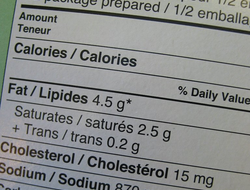Trans Fats: Friend or foe?
Published: July 02, 2021
Wasn't life simple when all you had to do, if you were health conscious, was reduce the amount of fat in your diet: any fat.
Nowadays you need to be able to distinguish “good” fats and “bad” fats or more precisely unsaturated fats from saturated fats and trans fats.
But why should you be reducing your consumption of saturated fats and trans fats?
Thirty years ago, when saturated fats from animal products were first associated with heart disease, partially hydrogenated vegetable oils, such as hard and semi soft margarine which contain trans fatty acids, were considered a healthy alternative.
However, trans fatty acids are now known to adversely affect blood cholesterol levels as much as saturated fatty acids, and are similarly associated with increased risk of cardiovascular disease (CVD).
More recent research appears to indicate that pregnant women who consume snacks and fast foods which contain trans fats may give birth to larger babies which increases risks at child birth both for mother and baby.
Because of these potential health risks trans fats, particularly those in snack foods and fast foods, have been identified as a target for reduction in commercially prepared food and for various nutritional health awareness campaigns.
In North America targets have been set for levels of trans fats in various foods.
However, the drive for regulation of these targets has diminished, particularly in Canada due to lack of government support, and consumers must fend for themselves.
Mandatory food labelling may not be providing you with accurate information about trans fats in processed food .
As a health conscious consumer you cannot assume that products, in the absence of a nutrition label stating the level of trans fats, are free from trans fats.
To complicate your food choice, some foods which contain trans fats have many nutritional benefits and the trans fats these foods contain may not be associated with adverse effects on health.
On the contrary, certain trans fatty acids may have health benefits.
How can you tell which foods contain the trans fats you should be avoiding?
The best way to ensure you are making the healthiest choices about the fat in your diet is to learn as much as you can about the fat of concern: in this case trans fats.
What are trans fats?
Trans fats, or trans fatty acids, are unsaturated fatty acids.
Instead of “cis” carbon double bonds associated with mono and polyunsaturated acids found in oils such as olive oil and canola oil, these fat molecules have “trans” carbon double bonds.
In general, fatty acids have a backbone of carbon with hydrogen atoms attached to it.
Saturated fatty acids are “saturated” with hydrogen atoms and as such no more hydrogen atoms can attach to the carbon back bone. Unsaturated fatty acids and...link to the full article to learn more.
References
1.
ahealthyphilosophy.com
2.
Clifton et al. (2006). Trans fatty acids in adipose tissue and the food supply are associated with myocardial infarction. Journal of Nutrition 134(4), 874-879.
3.
Gebauer, et al. (2011). Effects of ruminant trans fatty acids on cardiovascular disease and cancer: a comprehensive review of epidemiological, clinical, and mechanistic studies. American Society for Nutrition, Advanced Nutrition, 2, 332-354.
4.
Hjerpsted et al., (2011). Cheese intake in large amounts lowers LDL-cholesterol concentrations compared with butter intake of equal fat content. American Journal of clinical Nutrition, 94, 1479-1484.
5.
Cohen, et al. (2011). Maternal trans fatty acid intake and fetal growth. American Journal of clinical nutrition, 94, 1241-1247.

